6 Common Questions About Agile Procurement Answered


It’s common knowledge that procurement is all about acquiring products and services on time, at the right place, and for the right price.
And that’s true.
However, achieving these objectives in today’s ever-changing business landscape becomes almost impossible without agility.
Agile procurement is a transformative approach that makes procurement more flexible, collaborative, and ready to adapt to constant market changes and customer demands.
So, whether you’re a seasoned procurement professional or new to the concept, this article is tailored for you.
We’ll answer six common questions about agile procurement, including its definition, how to transition from traditional methods to the role of technology, and more.
Let’s begin.
Agile procurement is an innovative approach to sourcing and purchasing that prioritizes adaptability and responsiveness in today’s fast-paced business environment.
As Philip Ideson, founder of the Art of Procurement, aptly puts it:
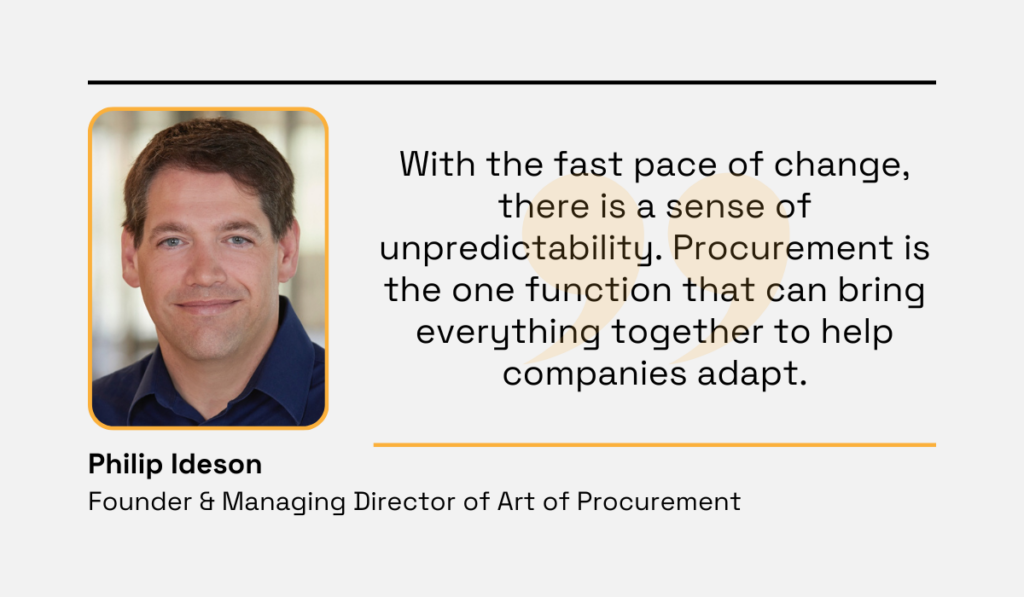
Illustration: Veridion / Quote: Jaggaer
That is—when executed with agility.
Unlike traditional procurement methods, which can be rigid and slow to adapt, agile procurement focuses on flexibility and collaboration.
This means that, instead of following a set process, agile procurement allows for adjustments and quick decision-making based on the current situation.
This flexibility is what makes agile procurement stand out and more effective in today’s fast-changing markets.
On top of that, agile procurement speeds up long traditional procurement processes and aims to deliver early value.
Take, for instance, CKW Group, the leading energy service provider in Central Switzerland.
When CKW decided to implement a new intranet system, they leveraged agile procurement methods to move from idea to execution faster.
Rather than following the typical weeks-long procurement process, CKW signed a letter of intent with the selected vendor just two days after the initial proposal.
How was this possible?
RFPs were replaced with in-person workshops with suppliers where they could discuss all the challenges and risks on the spot and see how suppliers collaborate and work in action.
By shortening supplier sourcing, they could decide quickly based on the facts before them, thereby significantly reducing the overall procurement timeline.
The result?
CKW’s new intranet was up and running within six months of the initial idea, a remarkable feat made possible by the agility inherent to their procurement approach.
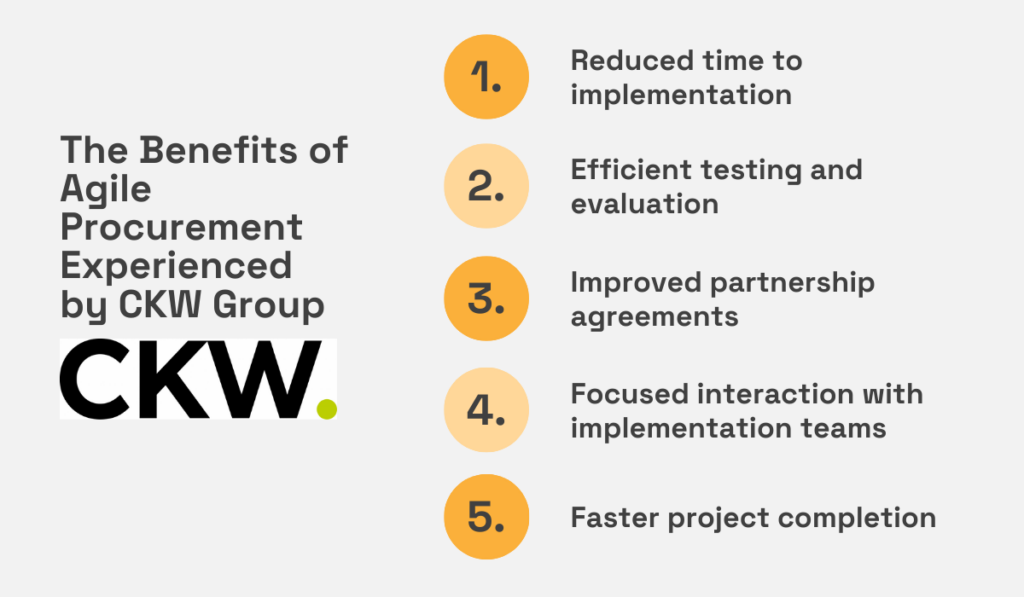
Illustration: Veridion / Data: LAP Alliance
In summary, agile procurement is all about speeding up processes and shortening procurement lifecycles, identifying risks sooner, closely collaborating with stakeholders and suppliers, and delivering early value to everyone involved.
Agile procurement is the future of sourcing and purchasing because it tackles the challenges of today’s fast-paced business world head-on.
In an environment marked by constant change and supply chain disruptions, traditional procurement methods often fall short.
However, agile procurement offers a smarter, more strategic approach that thrives on adaptability and responsiveness to these changes.
At its core, agile procurement is all about flexibility and adaptability throughout the supply chain.
This means being able to swiftly respond to shifts in supplier availability, pricing fluctuations, and even geopolitical risks.
A crucial ingredient?
Collaboration.
Agile procurement prioritizes building strong relationships with suppliers and fostering open lines of communication.
This builds resilience in supply chains and helps mitigate potential disruptions effectively.
Now, let’s talk about adapting to customer demands.
Picture yourself owning a trendy fashion store.
Your success hinges on staying ahead of the latest fashion trends and consumer preferences.
When a hot new trend hits the market, like a particular style of clothing or accessory, you need to move fast to get those items on your shelves before your competitors do.
With agile procurement, you’ve got streamlined processes in place to:
This agility keeps you ahead of the curve and attracts fashion-savvy customers eager to stay on trend.
Moreover, agile procurement often results in significant cost savings.
By optimizing processes, negotiating better deals, and reducing lead times, you can achieve considerable cost efficiencies.
But the perks of agile procurement don’t stop there.
For one, agile procurement fosters a culture of innovation and continuous improvement within organizations by breaking down departmental silos and promoting cross-functional collaboration.
This enhances decision-making and ignites creativity and innovation, leading to the development of cutting-edge strategies and solutions that give businesses a competitive edge.
All in all, the versatile benefits of agile procurement make it a game-changer in today’s hyper-competitive business landscape.
As companies continue to encounter new challenges and opportunities, agile procurement will undoubtedly play a central role in shaping the future of sourcing and purchasing.
To organize an agile procurement team, you need to bring together members from various departments, not just procurement, to ensure a comprehensive approach to sourcing and purchasing.
This diverse team includes professionals from procurement, legal, finance, operations, IT, and marketing, each contributing unique skills and perspectives.
| Role | Responsibilities |
|---|---|
| Procurement | Focus on cost-effectiveness and supplier management, ensuring efficient procurement processes. |
| Legal | Ensure compliance and mitigate legal risks. |
| Finance | Monitor budget allocations and cost projections. |
| Operations | Ensure seamless integration with existing processes. |
| IT | Evaluate technical requirements. |
| Marketing | Provide insights into branding and market positioning. |
Why does this matter?
Only such a team can make quick but aligned decisions and have the expertise to procure solutions that meet customer demands and departmental needs.
In addition to internal stakeholders, involving end-users and suppliers is crucial.
End-user feedback helps understand needs better, while continuous supplier engagement fosters collaboration, innovation, and risk mitigation.
A successful example of cross-functional team collaboration comes from Swiss Casinos in their ERP sourcing project.
The team responsible for sourcing and implementation closely collaborated with sponsors to define business objectives.
Throughout the project, they promptly addressed questions and concerns, providing weekly updates for transparency and alignment.
This approach led to maximum internal alignment, with stakeholders fully understanding the situation, including technical decisions, customer requirements, and contract drafting.
And it brought them significant benefits:
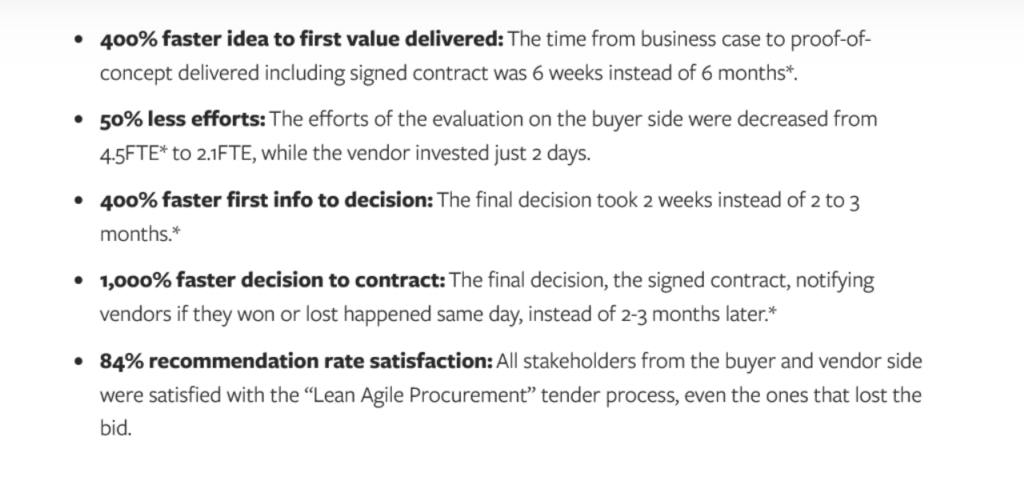
Source: Agile Business
In summary, organizing an agile procurement team involves bringing together a diverse group of experts—including internal stakeholders, end-users, and suppliers—to drive effective decision-making, collaboration, and innovation.
Transitioning from traditional to agile procurement involves moving away from rigid processes like RFPs and RFQs towards more flexible, collaborative methods.
Traditional procurement, with its focus on fixed-price contracts and competitive bidding, often leads to lengthy procurement cycles due to heavy documentation and predefined steps.
In contrast, agile procurement prioritizes flexibility, collaboration, and responsiveness.
Rather than solely seeking the lowest bidder, agile procurement looks for suppliers capable of collaborating, innovating, and delivering iteratively.
This transition requires a shift in mindset towards agile principles.
This, further, requires investment in training and development to help teams embrace change and continuous improvement.
A crucial aspect of this shift is the adoption of data driven decision-making.
Djordje Stevanovic, Director of Indirect Procurement at Zalando, a company that is built on agile principles, emphasizes the importance of basing decisions on data rather than gut feelings in agile procurement:
“Don’t come to me with a feeling, come to me with something that is really proven in the figures because then we can create the momentum and build on this. The secret to this is coaching and explaining why something is making sense to do it in this way.”
However, it’s on procurement leaders to coach teams and explain the reasoning behind decisions to encourage this approach.
In addition to relying on data, transitioning to agile procurement involves gradually integrating agile methodologies like Scrum, Kanban, or Lean into procurement practices.
This includes adopting iterative approaches to supplier sourcing, promoting ongoing collaboration, and implementing feedback loops to encourage continuous improvement.
By embracing agile principles, prioritizing data-driven decision-making, and gradually adopting agile methodologies, organizations can transform their procurement practices to be more adaptive, responsive, and aligned with business goals and customer needs.
Technology is a key enabler in making your procurement processes more agile.
According to procurement expert Alan Veeck, you should seek assistance from it:
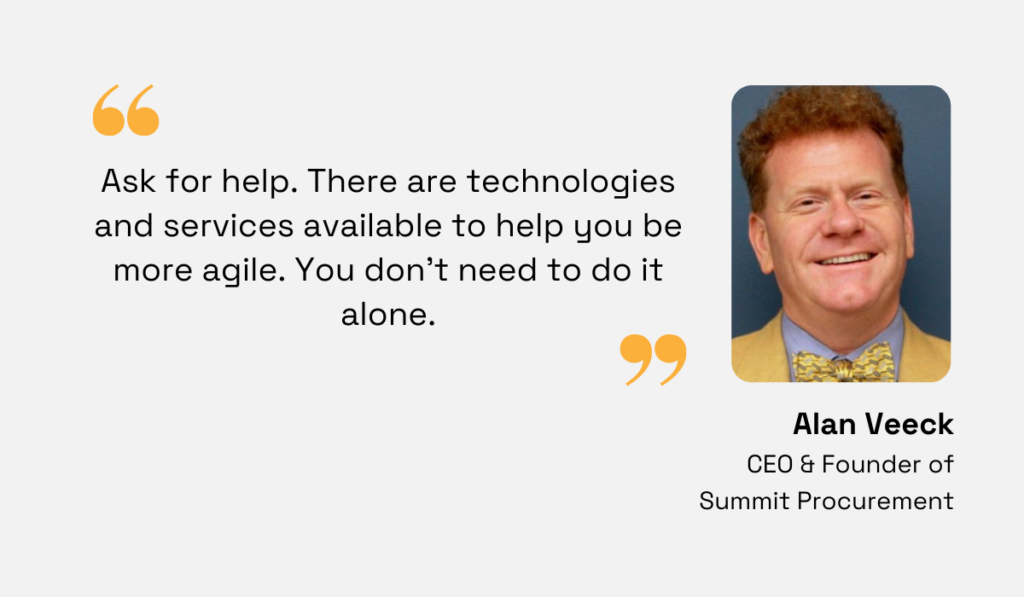
Illustration: Veridion / Quote: Jaggaer
Gabe Perez, a seasoned leader in procurement and spend management, further underscores the pivotal role of technology in enabling agility:
“In order to make this shift, technology is a key enabler to more agile processes. Using a platform that can enable collaboration with your internal stakeholders and external suppliers can foster innovation, a better experience and can increase the speed of business.”
Perez’s insights resonate particularly when considering procurement software.
This tool automates tasks and streamlines procurement workflows like generating purchase orders and making payments.
It also facilitates contract management and enhances supplier relationship management.
In other words, it enables collaboration that agile procurement depends on.
On top of that, procurement software generates and stores vast amounts of data, from which data analytics tools can extract actionable insights.
For example, with such data analytics, you can optimize procurement strategies, identify cost-saving opportunities, and mitigate risks more effectively, thereby increasing your agility and responsiveness to market dynamics.
Artificial intelligence (AI), machine learning, and natural language processing (NLP) technologies are also essential for agile procurement.
These technologies boast advanced capabilities such as automated supplier discovery, intelligent contract analysis, and predictive analytics.
They can significantly shorten the procurement cycle and improve decision-making accuracy.
For instance, our supplier sourcing enabler Veridion leverages AI and machine learning to revolutionize how you source suppliers.
Acting as a big data platform, Veridion continually updates its database with fresh information on millions of global suppliers and their products.
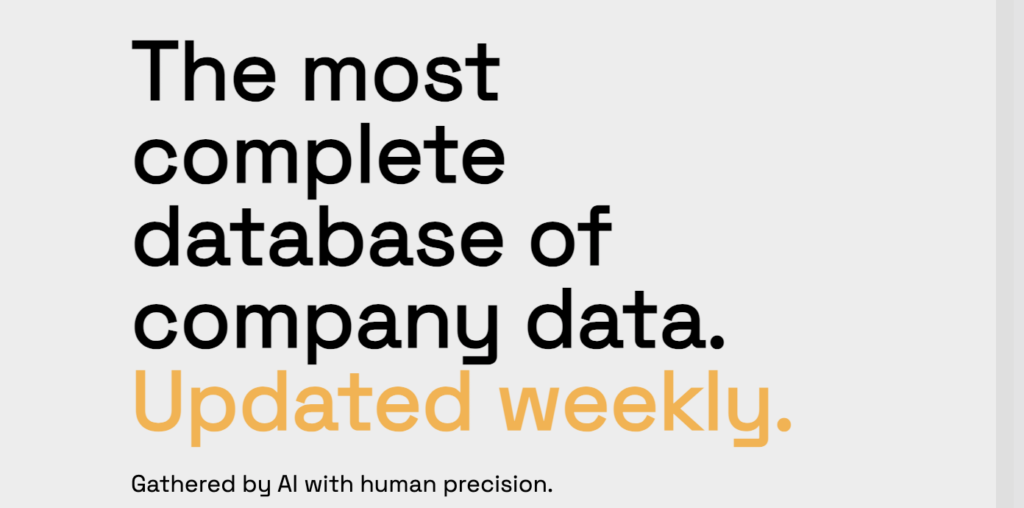
Source: Veridion
When searching for suppliers, you can simply enter criteria in our complex search APIs.
Then, Veridion quickly identifies suppliers that meet your specific criteria.
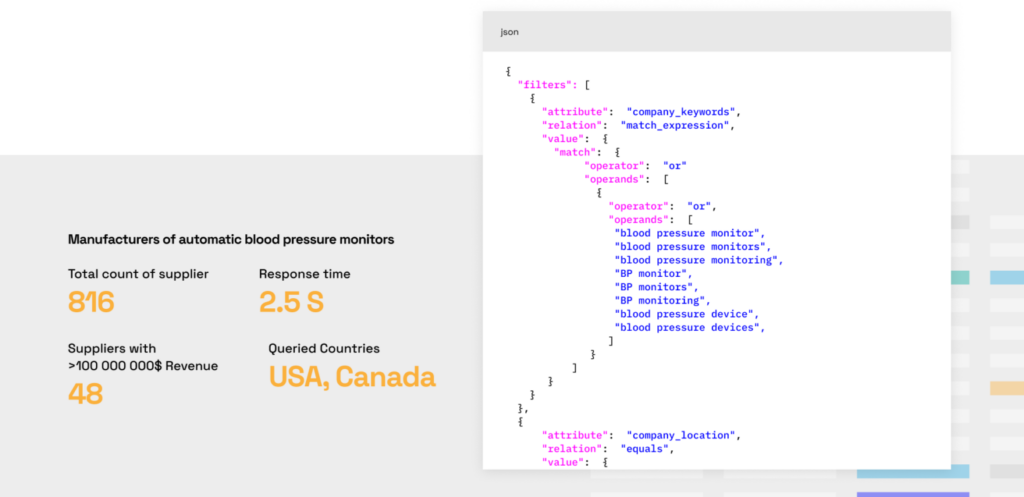
Source: Veridion
This speeds up the supplier discovery process, saving you weeks, if not months, of manual search time.
And, of course, this makes you more agile.
Even more so if you rush to quickly find new suppliers or make changes to existing ones.
Simply put, technology is instrumental in enabling agile procurement because it helps with collaboration, provides useful insights from data, and automates tasks.
All this together makes procurement faster, more responsive, and adaptable.
Transitioning to agile procurement presents numerous benefits, but it’s not without challenges.
Among the most common hurdles are:
Resistance to change is a natural response when introducing new tools or processes, especially among stakeholders accustomed to traditional procurement methods.
You may encounter reluctance or fear about embracing something unfamiliar.
However, with effective communication, training, and support, you can overcome this resistance and encourage acceptance of agile practices.
Legacy systems and processes designed for traditional procurement may not align with agile methodologies, posing another challenge.
Therefore, you may need to invest in technology upgrades to integrate legacy systems with agile practices effectively.
And the challenges go beyond your organization.
For example, explaining the need for a more flexible contract to your suppliers can also be quite challenging, as they, too, may not be ready to change.
Transparent communication about the mutual benefits of agility, such as the ability to respond quickly to market changes, can help suppliers understand the rationale behind such requests.
Despite these challenges, you can successfully transition to agile procurement with proper training, support, and a culture of innovation.
A notable example is the A1 Telekom Austria Group, where agile procurement brought significant benefits in terms of efficiency, cost savings, and talent management.
According to Michaela Mayrhofer, the group’s Director of Supply Chain, agile procurement enabled individuals to thrive in dynamic team structures, fostering rapid development and empowering teams to take responsibility:
“Some people who were only moderate performers in our old structure have become real stars in the new model. And it has proved to be a great way to develop people extremely rapidly. The dynamic team structures allow people to share ideas and learn from each other, and more junior personnel get lots of responsibility and exposure to senior colleagues.”
In conclusion, while agile procurement may present obstacles, you can overcome them.
Open communication, the right tools, and a commitment to improvement will ultimately help you reap the benefits of agility.
Today, we answered some of the most common questions regarding agile procurement.
From grasping the concept of agile procurement and its significance for the future to exploring the technological solutions that can enhance agility, we’ve covered a broad spectrum of topics.
All to shed light on the critical role of agility in your procurement processes.
Let’s be clear: Agile procurement is not just another trend; it is the very essence that will soon separate thriving businesses from those falling behind.
So, make sure you’re heading in the direction of agility.
It’s the pathway to more flexibility, adaptability, and innovation that will help you maintain competitiveness and stay ahead in an ever-evolving business landscape.